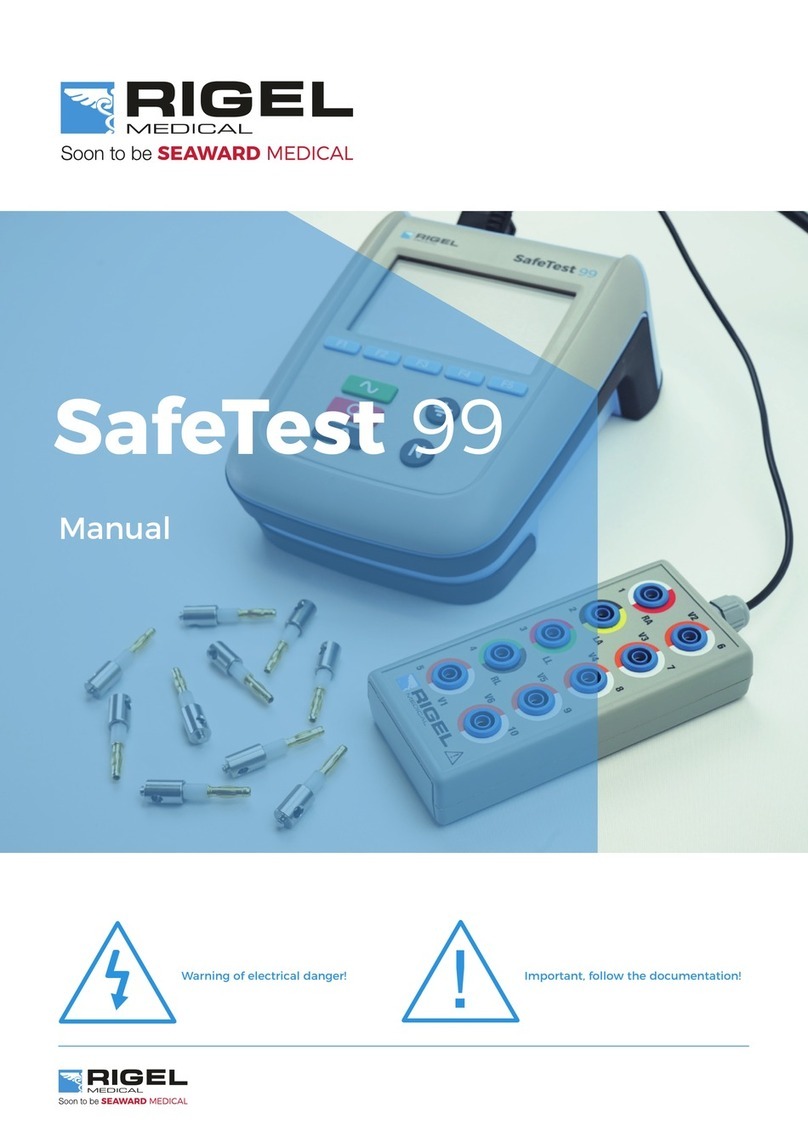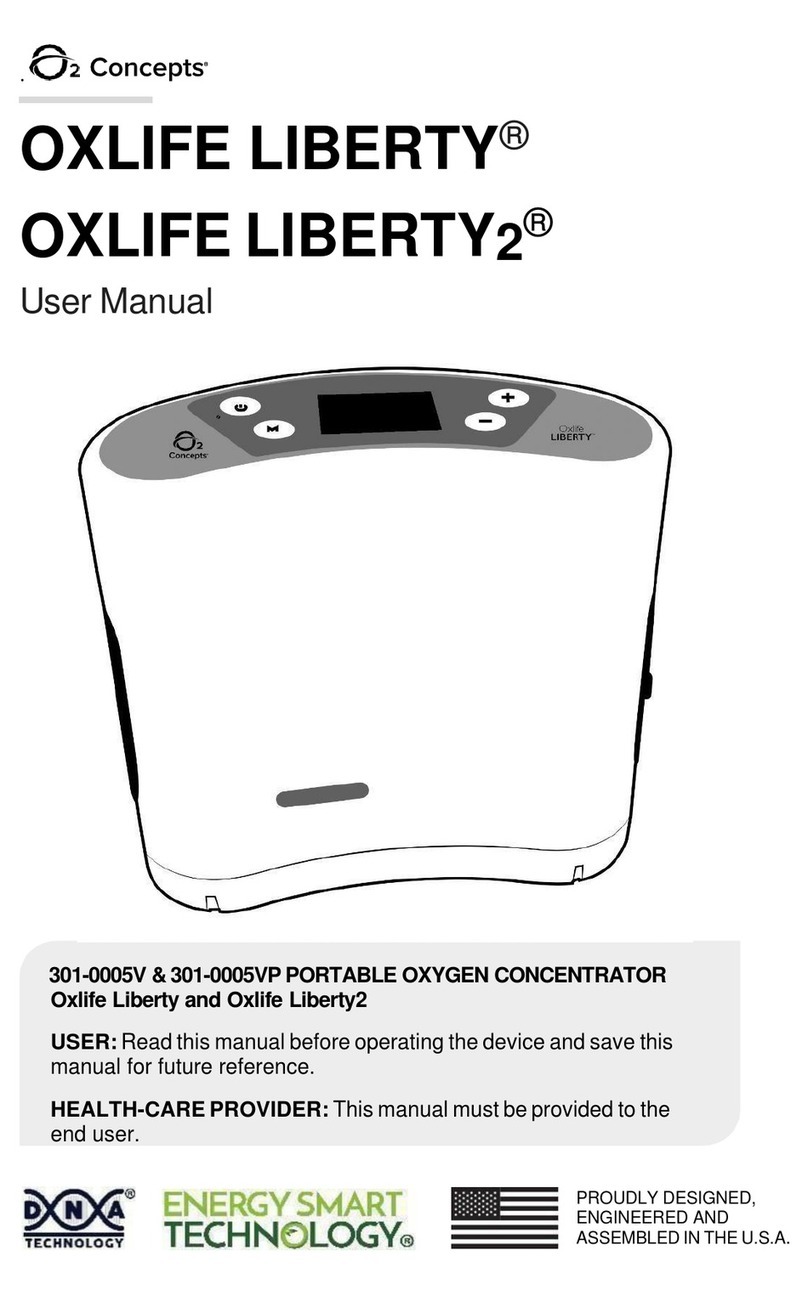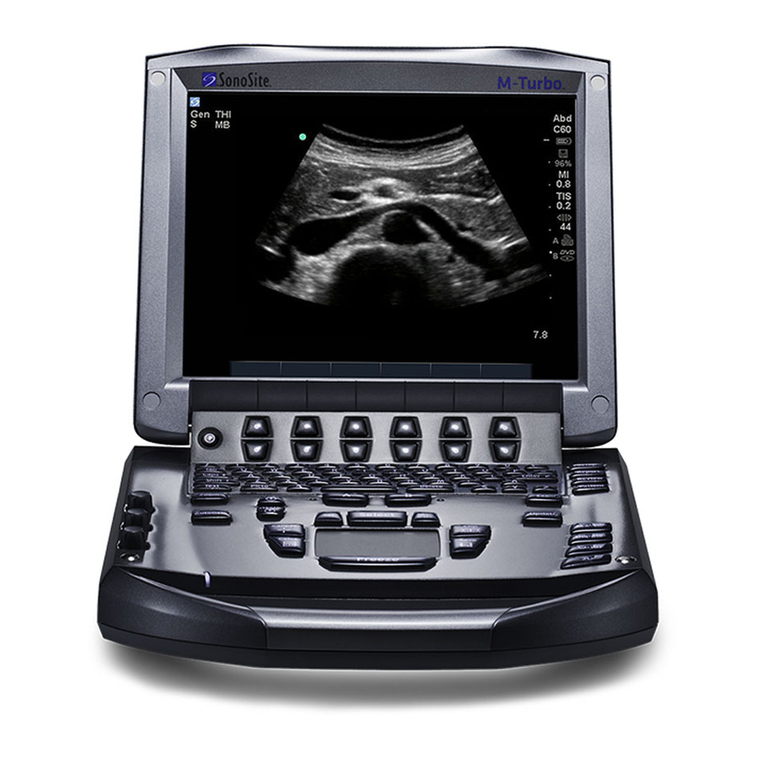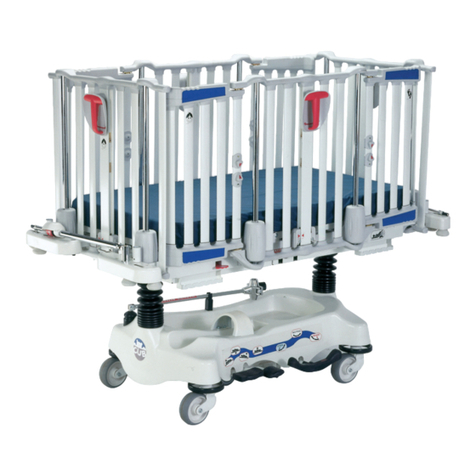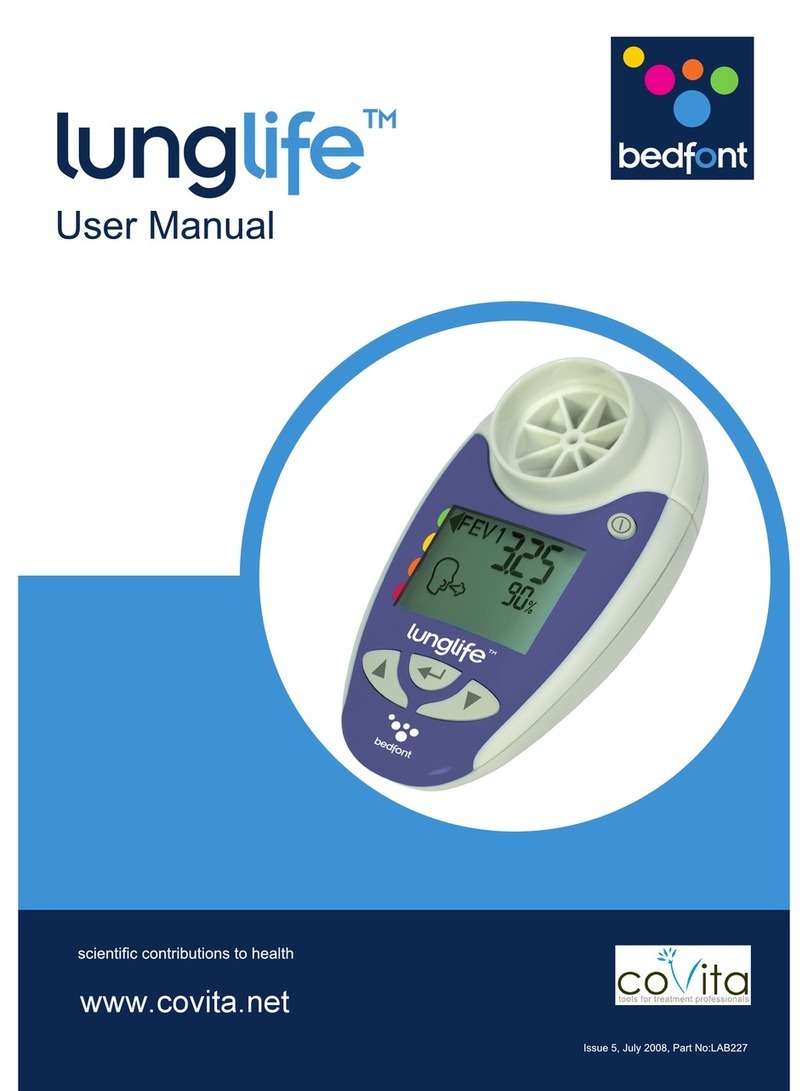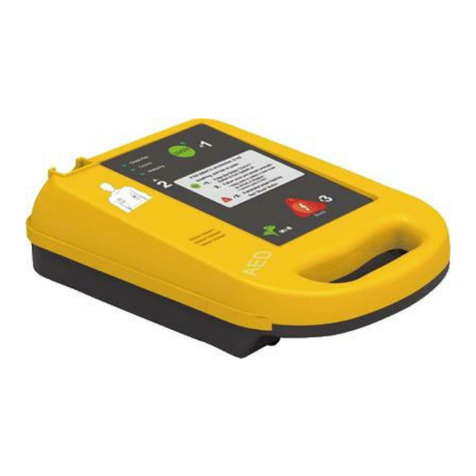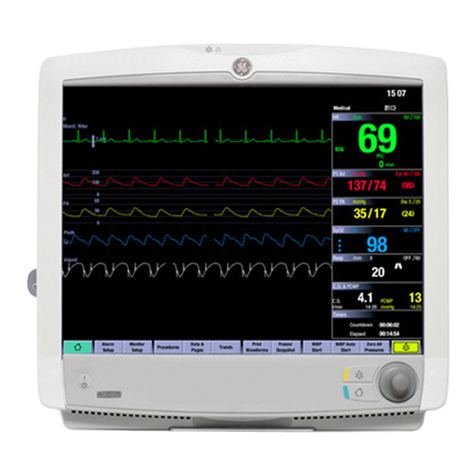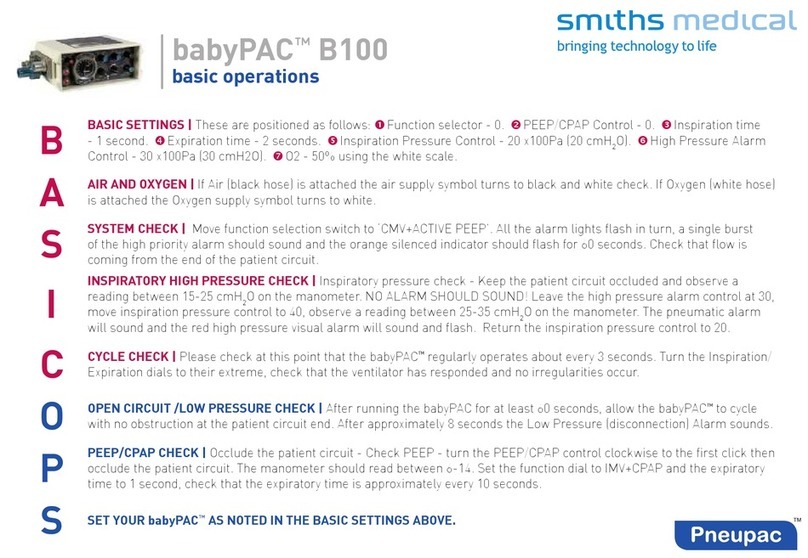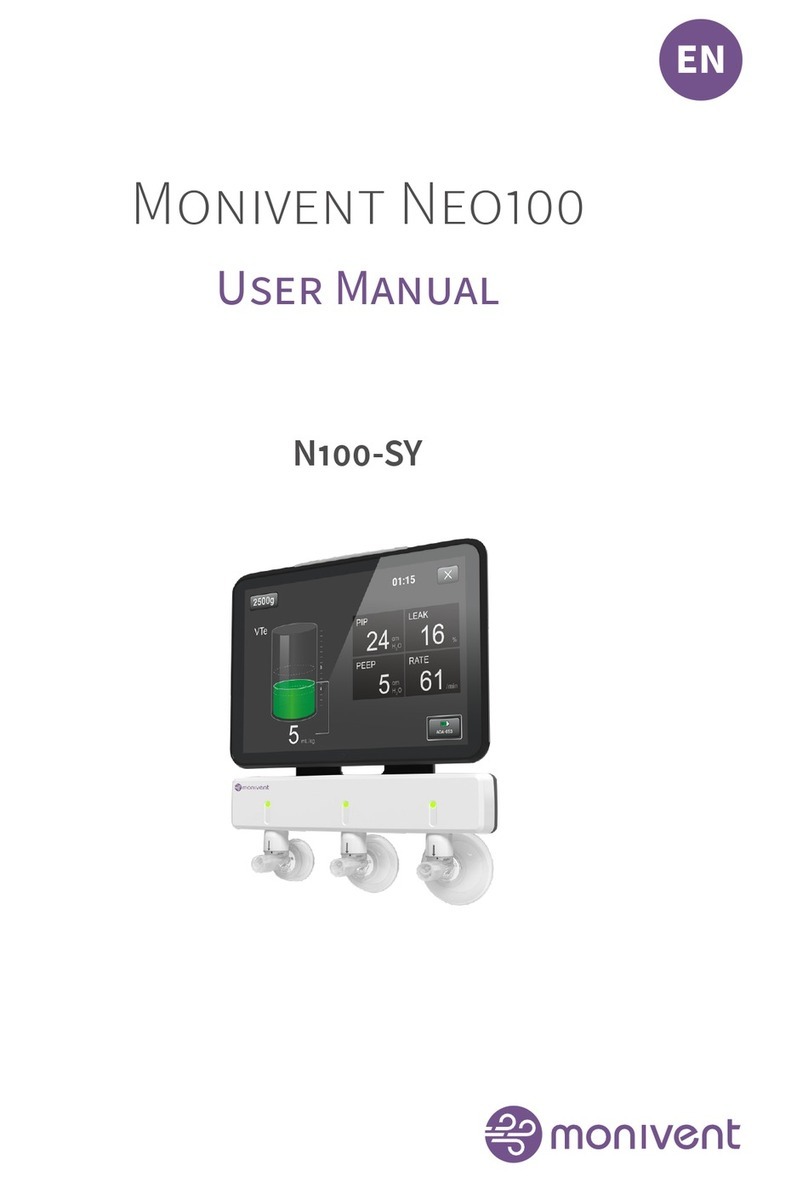Seaward Rigel 62353+ Instruction Manual

A Practical Guide to IEC 62353
rigelmedical.com

RIGEL MEDICAL
PG 2 TESTED, TRUSTED… WORLDWIDE.
© Copyright 2019 - All rights reserved. Nothing from
this edition may be multiplied, or made public in any
form or manner, either electronically, mechanically, by
photocopying, recording, or in any manner, without
prior written consent from Seaward Electronic Ltd. This
also applies to accompanying drawings and diagrams.
CONTENTS
03 Foreword
04 Introduction
07 Medical electronic
equipment
11 IEC 60601
12 Introduction to IEC
62353: 2014
15 Visual inspection
15 Earth bond testing
18 Insulation resistance
test
22 IEC 62353 leakage
measurements
33 Record keeping
34 Conclusion
36 Appendix A: Pass/fail
limits of IEC 62353
37 Appendix B: IEC 60601-
1 collateral standards
38 Appendix C: IEC 60601
test standards
43 Appendix D: Patient
environment
44 Appendix E: Example
documentation
45 Products in the Rigel
Medical range
46 Accessories and services
from Rigel Medical

A PRACTICAL GUIDE TO IEC 62353
PG 3
43 Appendix D: Patient
environment
44 Appendix E: Example
documentation
45 Products in the Rigel
Medical range
46 Accessories and services
from Rigel Medical
Rigel Medical:
Keeping
medical
industries safe
World-leading biomedical test
and measurement equipment
At Rigel Medical, we’ve been a pioneer
of biomedical test and measurement
instruments for more than four decades.
Since launching the world’s first IEC 601
electrical safety analyser in the 1970s, our user
focused developments continue to place us at
the forefront of the industry.
Our comprehensive suite of electrical
safety analysers, performance analysers and
vital signs simulators enable biomedical
and clinical engineers to confirm their
adherence to a series of industry standards,
manufacturers’ specifications and most
importantly, keeping patients, visitors, and
staff safe in a healthcare environment.
Alongside our commitment to quality, we also
offer peace of mind to our customers who
know that help and advice is always available.
Foreword
This booklet is written as a guideline for
people involved in testing medical electrical
(ME) equipment.
This booklet cannot be considered as a
replacement for the IEC 62353 publication,
which can be purchased through the official
IEC website, http://webstore.iec.ch/.
All reasonable care has been taken to
ensure the accuracy of the information,
reference figures and data has been taken
from the latest versions of various standards,
guidance notes and recognised ‘best
practices’ to establish the recommended
testing requirements however, Rigel Medical,
their agents and distributors, accept no
responsibility for any error or omissions within
this booklet, or for any misinterpretations by
the user.
For clarification on any part of this booklet
please contact Rigel Medical before operating
any test instrument, under relevant legislation.
No part of this publication shall be deemed to
form, or be part of any contract for training or
equipment unless specifically referred to as an
inclusion within such contract.
Rigel Medical assumes that the readers of
this booklet are electronically technically
competent and therefore, does not accept
any liability arising from accidents or fatalities
resulting directly or indirectly from the tests
described in this booklet.
Author John Backes, MA

RIGEL MEDICAL
PG 4 TESTED, TRUSTED… WORLDWIDE.
Introduction
This guide covers a basic introduction to
electrical safety, definitions of a medical
electronic device, the IEC 60601 standard
and an in depth overview of the IEC 62353
publication.
The structure and topics discussed in this
guide are written in a way such that the widest
possible audience can benefit.
Electrical current
Electrical current is a secondary energy form
consisting of the flow of charge (in coulomb)
through a circuit over a certain time period,
and is depicted in ampere.
I = Q/t or 1 Ampere = 1 Coulomb/1 second
When electrical current passes through a
conductor or electrical circuit, it generates an
electrical potential, as displayed in
Figure 1
.
There is a directly proportional relationship
between the electrical current (ampere)
through and the electrical potential (volt)
across the conductor (ohm). This is commonly
known as Ohm’s law:
V (b - a) = I x R
The force required to deliver the electrical
current across a potential difference is known
as power, which is represented in watts. Power
is a product of voltage (volt) and current
(ampere):
Another factor of electricity is electrical energy
(joules), a product of electrical power (watts
or joules/second) and time (seconds). The
relationship is provided below:
The relationship between current, voltage and
resistance can be equally applied to water
running through a pipe. In both cases, electric
current and water prefer the path of least
resistance. The larger the cross section of the
pipe or conductor, the easier water or current
can flow at a certain water pressure or voltage
(
Figure 2
).
Conductor resistance (R)
Electrical current (I)
Electrical potential
(Va-Vb)
Ohm’s law;
V(a-b) = I x R
A B
O
h
m’s
l
aw;
V
(
a-
b)
= I x R
Figure 1 - Ohm’s Law
Power in Watts:
P = V x I
Power in Watts:
P = I2 x R
Power in Watts:
P = V2 / R
Energy in J’s
E = P x t
Energy in J’s
E = (V2 x t) / R
Energy in J’s
E = I2 x R x t

A PRACTICAL GUIDE TO IEC 62353
PG 5
∙The thinner or longer the water pipe, the
more water pressure is required to deliver
the same litres per minute (flow or current)
∙The thinner or longer the conductor
(assuming a particular specific resistance of
material), the more voltage is required to
deliver the same current.
The human body
A significant part of the human body is made
up of water along with dissolved ions and
minerals, which are capable of conducting
electrical currents. Broadly speaking, the hazard
of such electrical currents would depend on:
∙Strength of the current
∙Path of the current
∙Total impedance for the current path
∙Frequency of the current
∙Duration of the current being applied
Electrical currents can be extremely dangerous
to the human body. The energy released by
electrical current passing through human tissue
can generate burns and excite or stimulate
muscles of the respiratory system (intercostal).
The most critical muscles are those in the
human heart, which are driven (excited) by very
tiny amounts of electrical currents. When the
heart is exposed to external electrical currents
(electrical shock), the heart can lose its normal
sinus rhythm, required to sustain a healthy
Power in Watts:
P = V x I
Power in Watts:
P = I2 x R
Power in Watts:
P = V2 / R
Energy in J’s
E = P x t
Energy in J’s
E = (V2 x t) / R
Energy in J’s
E = I2 x R x t
Figure 2 - Example showing water following path of least
resistance
Water Electricity
Current or flow Litre/second Current Ampere (coulomb second)
Pressure e.g. bar or psi Voltage Volt
Resistance Affected by pipe cross
section and length
Resistance In ohm (Ω). Affected by
conductor cross section, length
and material

RIGEL MEDICAL
PG 6 TESTED, TRUSTED… WORLDWIDE.
blood circulation, and move into ventricular
fibrillation. This stops the circulation of
oxyhaemoglobin (oxygenated blood) to the
brain and organs and when left untreated, will
result in death within 15 minutes.
Ironically, the most common treatment of
ventricular fibrillation is the use of a defibrillator
which delivers a very high current pulse, up
to 100A across the heart. The energy in that
high current pulse is sufficient to temporarily
clamp the heart muscles (i.e. stop the heart
completely) before releasing it again and
allowing the heart to resume its normal sinus
rhythm.
Consider the following examples of a macro
shock showing the effect of a 50/60 Hz current
on the human body when applied to the skin
for 1–3 seconds non-invasively:
0.5 -1.1 mA Current just noticeable when
applied to the fingertip.
6 – 16 mA Painful shock, unable to let go,
cannot be tolerated over 15 minutes.
75-400 mA Ventricular fibrillation,
respiratory arrest, leading to death.
<1 A Serious burns and muscular
contraction of such a degree that the
thoracic muscles constrict the heart.
Figure 3
highlights the different effects of
electrical current on the human body as
understood by Dr. Howard M. Hochberg;
IEC 60601 body model
To ensure a standardised method of
simulating the impedance of the human body,
measurement circuits have been designed
to simulate the average, typical electrical
characteristics of the human body. These
measurement circuits are referred to as a body
model or measuring device
(MD in IEC 60601-1).
The main impedance is formed by a 1kΩ
resistor, shown in
Figure 4
.
Figure 3 - Impact of current on the human body, adapted
from research by Howard M. Hochberg, 1971
(Data adapted from published research by Professor C.F. Dalziel)

A PRACTICAL GUIDE TO IEC 62353
PG 7
Medical electronic
equipment
Heath facilities including hospitals, surgeries,
GP practises, veterinarian clinics, and dentists
use a variety of electrical equipment, ranging
from, specialist medical, laboratory and IT
equipment to ordinary domestic appliances.
Any electrical equipment with the purpose of
treating, monitoring or diagnosing a patient’s
condition is classed as a medical electronic
device according to IEC 60601, the global
harmonised standard governing the design and
approval of medical devices.
The official definition of medical electrical
equipment according to IEC 60601 is:
“Electrical equipment, designed for
treatment, monitoring or diagnoses of
patients, powered from not more than one
connection to mains supply and which are
necessarily in physical or electrical contact
with the patient or transfers energy to or
from the patient or detects such energy
transfer to or from the patient.”
Medical and non-medical electronic
equipment can also be combined into a
Figure 4 - Example of a measuring device (MD) to IEC 60601
z (
f
)
z (
f = 10)
Note: The network and voltage measuring instrument above are replaced by the symbol
in the following figures:
a) Non-inductive components
b) Impedance >> measuring impedance Z
c) Z (
f
) is the transfer impedance of the network, i.e. V
out/in, for a current frequency
f
f

RIGEL MEDICAL
PG 8 TESTED, TRUSTED… WORLDWIDE.
medical electronic system. To ensure safety of
patient and operator, this system must meet
the design requirements of IEC 60601.
The definition of a medical electronic system is:
“Combination of equipment of which at
least one is classed as medical electrical
equipment and as such specified by the
manufacturer to be connected by functional
connection or use of a multiple portable
socket-outlet.”
Commonly used terms and definitions
in IEC 62353
Equipment under test - The equipment (EUT)
which is the subject of testing.
Device under test (DUT) - The device which is
the subject of testing.
Applied part - Part of the medical equipment,
which is designed to come into physical
contact with the patient, or parts that are
likely to be brought into contact with the
patient.
Patient connection - Individual physical
connections and/or metal parts intended for
connection with the patient, which form (part
of) an applied part.
Patient environment - Volumetric area in
which a patient can come into contact with
medical equipment or contact can occur
between other persons touching medical
equipment and the patient, both intentional
and unintentional. (see
Appendix D
).
F-Type applied part - Applied part which is
electrically isolated from earth and other parts
of the medical equipment, i.e. floating. F-Type
applied parts are either type BF or type CF
applied parts.
Type B applied part - Applied part complying
with specified requirements for protection
against electric shock. Type B applied parts are
those parts, which are usually earth referenced.
Type B are those parts not suitable for direct
cardiac application.
Type BF applied part - F-Type applied part
complying with a higher degree of protection
against electric shock than type B applied
parts. Type BF applied parts are those parts not
suitable for direct cardiac application.
Type CF applied part - F-Type applied part
complying with the highest degree of
protection against electric shock. Type CF
applied parts are those parts suitable for direct
cardiac application.
Class I - Equipment protection against electric
shock by (earthed) additional protection to
basic insulation through means of connecting
exposed conductive parts to the protective
earth in the fixed wiring of the installation.
Class II - Also referred to as double insulated.
Equipment protection against electric shock
is achieved by additional protection to basic
insulation through means of supplementary
insulation, there being no provision for the
connection of exposed metalwork of the
equipment to a protective conductor and no
reliance upon precautions to be taken in the
fixed wiring of the installation.

A PRACTICAL GUIDE TO IEC 62353
PG 9
Protective earth - Dedicated circuit intended
to carry the fault and leakage current in Class
I equipment and to be connected to the
protective earth terminal.
Functional earth - Dedicated circuit intended
to provide an electrical screening and to be
connected to a functional earth terminal.
Line to earth voltage - Applied voltage
between the live wire and earth conductor,
affecting the leakage current.
Leakage current - Current that is not functional.
Macroshock - Non-invasive applied current
which passes from one side of the body to the
other, typically hand to hand or hand to foot,
and therefore crossing through the heart.
Microshock - Invasively applied current which
passes directly across the heart tissue.
Note: Class II equipment may be provided
with a functional earth terminal or a
functional earth conductor.
Symbols and markings
The IEC 60601 defines the requirements for
information/data to be present on the medical
equipment’s nameplate, in order to form an
unambiguous identification of the equipment.
Information must include; manufacturers
name, model number, serial number, electrical
requirements.
The IEC 60601 standard refers to a large variety
of symbols for use on medical equipment,
medical systems, accessories and other related
parts. A full overview of the symbols used in IEC
60601 is provided in table D1 of the standard.
For the purpose of this booklet, a selection of
the most commonly used symbols is displayed
below:
Product lifecycle
For many years, ME equipment has been
subject to extensive approval processes from
clinical trials, to type testing all the way through
to end of production line testing, to ensure it
operates properly before leaving the factory.
In addition, manufacturers recommend
that regular electrical safety and essential
performance checks are carried out to ensure
Protective
Earth
Earth
reference
point
Functional
Earth Class II
i.e.
“Conformité
Européenne”
Type B
applied part
Defibrillation-
proof type B
applied part
Type BF
applied part
Defibrillation-
proof type BF
applied part
Type CF
applied part
Defibrillation-
proof type CF
applied part

RIGEL MEDICAL
PG 10 TESTED, TRUSTED… WORLDWIDE.
there’s no risk of harm to the patient and
operator once the device goes into service.
Design
During this stage a concept is subject to initial
and clinical trials. Electronic and mechanical
design of the product (where applicable) must
be in line with the IEC 60601 standard.
Type test
During this stage the product is expected
to have completed the clinical trials and,
subject to type testing, is ready for marketing.
The hardware and software of the product is
verified against the design standards. When CE
marking is obtained, the medical product can
be marketed in the European Economic Area.
End of line test
During this stage the products are being
assembled, tested and inspected for release
into the market place.
Acceptance
Once a medical device reaches the client,
an acceptance test is performed. This test
is to verify that the device is delivered in an
acceptable condition, complete without
any defaults and available with all specified
accessories. A performance and electrical safety
test are often completed as part of a reference
for future maintenance.
Operator training
Maintenance
Planned Preventative Maintenance (PPM) is
a process whereby the device is subject to
scheduled inspections and tests in order to
verify that the safety and operation are within
acceptable levels and criteria. This is referred to
as proactive maintenance.
Repair
Should a device create a fault or require an
upgrade, the device will be susceptible to
further inspections and testing. This is referred
to as reactive maintenance.
Decommissioning
At the end of a product lifecycle, is the
decommissioning stage. The device, depending
on its function and material content may
be required to follow a set process (i.e. An
environmentally hazardous product will need
to follow a recycling process. Under certain
conditions, the device can be made available to
other organisations in which a second lifecycle
can start at the acceptance stage.
SAFETY
DESIGN
(IEC 60601)
TYPE TEST
(IEC 60601)
END OF LINE
TEST
ACCEPTANCE
OPERATOR
TRAINING
MAINTENANCE
(IEC 62353)
REPAIR
(IEC 62353)
DECOMMISSIONING
Figure 5 - Safety stages through product lifecycle

A PRACTICAL GUIDE TO IEC 62353
PG 11
IEC 60601
ME equipment must meet the design
requirements as set out by the IEC 60601
(a harmonised standard), which has been
adopted by all IEC member states. This sets out
all the design criteria for producing equipment
that is electrically and mechanically safe, as
well as placing the onus on the manufacturer
to understand how to reduce the risk of harm
when patient and operators are exposed to
their medical devices. All tests relating to the
electrical safety of ME equipment and devices
can be categorised into two categories:
∙Means of operator protection (MOOP) -
Means of protection for reducing the risk
of electric shock to persons other than the
patient
∙Means of patient protection (MOPP) -
Means of protection for reducing the risk of
electric shock to the patient
To ensure that ME equipment does not pose
an electrical hazard to the patient, or any other
person, it is designed with sufficient levels of
isolation (dielectrics) to reduce the amount of
electrical leakage current to an acceptable and
safe level - as low as 10µA . This is achieved by
separating high electrical potentials from any
conductive parts, accessible to the operator
or patient. Dielectric strength is proven by
applying a high voltage between high and low
electrical potentials. However, this could lead
to a breakdown of the isolation and would
therefore be referred to as a destructive test.
A safer way to test the effectiveness of
dielectrics is to perform a number of electrical
leakage tests, such as leakage originating from
the power supply to the enclosure (MOOP) or
protective earth wire (MOOP and MOPP) or
even to the patient connected parts (MOPP).
In IEC 60601, the test requirements for
electrical leakage must be carried out under
the worst possible conditions to ensure
maximum safety. This is achieved using
an elevated mains at 110% of the highest
expected voltage (i.e. at 240V mains this
would mean testing at 264V) and also by
preconditioning the ME equipment prior to
testing, before performing tests under normal
condition (no fault conditions), and including
any one of the specific and relevant fault
conditions.
Testing the protective earth circuit design
for sufficient current carrying capabilities is
achieved by stressing the design, passing a
minimum test current of 25 ampere RMS
through the circuit for a minimum of 10
seconds. At these current levels, time duration
and resistance values (<0.1 Ohm internal
equipment resistance), enough energy will be
created to convert current into thermal heat. By
observing the thermal profile of a design, one
can establish parts of the design that might
need to alter in order to reduce the electrical
resistance and therefore the converted energy
is:
E = I2 x R x t
Conducting such tests during the development
and approval stages of a product life cycle
provides sufficient levels of confidence that the
ME equipment meets the design requirements
of IEC 60601. Once a design is approved for

RIGEL MEDICAL
PG 12 TESTED, TRUSTED… WORLDWIDE.
manufacturing and marketing, a subset of tests
will suffice to ensure the product has been
built and assembled to the required product
quality and safety requirements. This subset of
tests is commonly referred to as routine tests
and are not clearly defined in IEC 60601, and
can therefore vary between manufacturers and
product designs. It’s for this reason that the IEC
62353:2014 makes a recommendation that IEC
62353 is used during final testing and before
putting a piece of ME equipment into service.
In-service test requirements
IEC 60601-1 does not provide any guidance
on routine test requirements. This has led to
different interpretations on how to apply IEC
60601 to routine test scenarios.
Once a medical device leaves the factory,
a number of potential test scenarios arise,
including:
Acceptance testing also referred to as an initial
or reference test. This test is carried out prior
to a new medical device being authorised for
use and is undertaken to ensure correct and
complete delivery. Acceptance testing is often
not limited to an electrical safety test, with
some basic function tests also being applied to
verify correct performance.
Routine testing also referred to as planned
preventative maintenance (PPM). This form
of testing is often conducted at fixed time
intervals, which vary between types of
equipment, manufacturers’ recommendations
and risk assessment procedures undertaken
by individual biomedical/clinical engineering
or medical physics departments. Routine
testing is not limited to safety testing and often
includes the verification of correct functionality.
After service and repair testing this is carried
out following a repair or product upgrade
and is often part of a service carried out by
in-hospital mechanical or clinical engineering
teams. In many cases, more rigorous electrical
safety testing is needed after the replacement
of components or reconfiguration of medical
devices.
Introduction to
IEC 62353: 2014
As its full name implies, IEC 62353 Medical
Electrical Equipment - recurrent test and
test after repair of ME equipment defines the
requirements for electrical safety testing of
medical electrical (ME) equipment and systems
during routine intervals.
Following the need for a unified approach to
routine testing, the first edition of IEC 62353
brought together a set number of tests to allow
its users to test the MOOP and MOPP dielectric
integrity via two distinct leakage current tests:
∙Equipment leakage - Testing the total
leakage generated from the incoming
mains to the rest of the equipment
(confirming integrity of the MOOP)
∙Applied part leakage - Testing that floating
applied parts (Type BF and Type CF) remain
at an acceptable floating level (confirming
integrity of the MOPP)
In meeting this requirement the IEC 62353
incorporates tests beyond those of type testing.
Specifically, it seeks to provide a uniformed and
unambiguous means of assessing the safety
of medical equipment, whilst maintaining the
relevance to IEC 60601-1 and minimising the

A PRACTICAL GUIDE TO IEC 62353
PG 13
risks to the person conducting the assessment.
Importantly, the IEC 62353 standard recognises
that the laboratory conditions described
in the IEC 60601, such as elevated mains,
isolated TN (terre neutral) supply, temperature
and humidity conditions cannot always be
guaranteed when in-service testing of medical
devices is undertaken. More commonly,
secondary earth connections caused by data
cables and systems, provided measurement
errors that can now be overcome by IEC 62353.
Another factor raised is that equipment could
potentially be damaged by applying type test
specifications (IEC 60601) when in service and
could therefore represent a potential danger to
users.
One of the most significant changes to the
2014 edition is the recommendation to test
according to IEC 62353 at the final production
line stage and also before equipment goes
into service. This will allow recurrent testing
to be directly comparable with factory tests,
providing for easier greater observation of
any variations in leakage measurement. New
in the IEC 62353:2014 edition is a number of
suggested leakage tests that would isolate
the touch leakage current or patient leakage
current. Both tests form part of the equipment
leakage current.
However, if a manufacturer wants to provide
a specific measurement, the IEC 62353:2014
now provides guidance for these tests to
be conducted in the informative section of
the standard, which might be considered
when the equipment leakage values have
changed from previous measurements. The
500V DC insulation tests in the 2014 edition
have also been supplied with recommended
pass/fail limits, taken from internationally
accepted practices for insulation testing of
electrical equipment. While insulation tests
are optional, it’s recommended to check with
the equipment manufacturer if this can be
conducted without damaging the equipment
under test.
The strength of IEC 62353 enables those who
carry out testing to conduct a summary of tests
on the input of medical devices (equipment
leakage) and on the output of the medical
equipment (applied part leakage). As will
become evident from the following chapters,
the time saving associated with IEC 62353 will
also allow for more time to be spent on visual
and functional testing.
How does IEC 62353 compare with
IEC 60601?
Although IEC 60601 is a type test standard
governing the safety of the design and
manufacture of ME equipment, for decades
biomedical and clinical engineers have used
the IEC 60601 as the basis for regular testing
or after service/repair of medical devices. Local
variants of IEC 60601 have also been adopted
and used as a basis for routine testing.
It is clear that most commonly used electrical
safety analysers will only provide means of
testing to a subset of tests described in IEC
60601 and often exclude destructive tests such
as high voltage dielectric testing, constant
current 25A testing and SIP/SOP fault condition
testing to aid portability and safety of the
operator.
So what are the main implications of testing to
IEC 62353 and how does it differ from the very
well established and widely understood

RIGEL MEDICAL
PG 14 TESTED, TRUSTED… WORLDWIDE.
requirements of IEC 60601?
Test frequency
To ensure safety and performance is managed
throughout the lifecycle of medical electrical
equipment, manufacturers must specify
the intervals for testing and inspecting their
devices. The basis for this is risk assessment:
the likelihood of occurrence and severity of
incorrect operation. Consideration has to also
be given to the application of the product,
frequency of use, the operational environment
and operator competency. IEC 62353:2014
recommends following the manufacturer’s
instructions on test intervals. If this is not
available, a test interval between of between 6
and 36 months is suggested depending on risk
assessment.
Technical considerations
The aim of IEC 62353 is to provide a uniform
standard that ensures safe practices and
reduces the complexity of the current IEC
60601-1 standard. All tests are based on
leakage testing to IEC 60601, but a number of
aspects to improve safety and practicality have
been removed.
The most significant changes are:
∙No pre-conditioning of equipment under
test
∙No elevated mains
∙No destructive testing
∙Testing under single fault condition only
∙Summarising leakage into input and output
safety
∙Testing at applied part level rather than at
patient connection
- Different methods for conducting leakage
tests subject to practicality
Many IEC 62353 tests are directly related to IEC
60601 tests, which is shown in
Figure 6
.
IEC 60601 IEC 62353
Earth leakage Equipment leakage DIR/DIF
Earth leakage SFC neutral Equipment leakage ALT
Enclosure leakage SFC earth Equipment leakage DIR/DIF
Patient leakage Equipment leakage (enclosure probe
disconnected)
Mains on applied parts Applied part leakage
Measured values Some are calculated
Only direct method Direct/Differential and alternative
Figure 6 - Comparing IEC 60601 with IEC 62353

A PRACTICAL GUIDE TO IEC 62353
PG 15
Vital preparation
Although IEC 62353 was first published in
May 2007, many companies and organisations
are still in the process of making changes to
their approach to electrical safety testing. To
incorporate the IEC 62353 test philosophy
into any organisation requires necessary
preparation. Options for choosing the correct
set of tests requires an understanding of the
purpose and benefits of using the different
tests available.
Although the onus will inevitably fall on the
manufacturers of medical devices to advise
on appropriate in-service test procedures for
their own equipment, IEC 62353 clearly has
an impact on medical service companies,
biomedical engineering, medical physics,
clinical engineering and other technical
departments.
To help all those likely to be affected by the
introduction of IEC 62353 tests, a summary of
the test requirements is provided within this
guidance booklet.
This IEC 62353 guidance booklet is intended
for general information only and cannot be
considered a substitute for the full version of
the standard.
Visual inspection
The process of visual inspection is not
clearly defined by IEC 60601, however visual
inspections form a critical part of the general
safety inspections during the functional life of
medical equipment. In most cases, 70% of all
faults are detected during visual an inspection.
A visual inspection is a relatively easy
procedure, which is carried out to ensure that
the ME equipment in use still conforms to the
specifications released by the manufacturer
and has not suffered from any external damage
and/or contamination.
The following inspections can be included:
∙Housing/enclosure - look for damage,
cracks etc.
∙Contamination - look for obstruction of
moving parts, connector pins etc.
∙Cabling (supply, applied parts etc.) - look
for cuts, wrong connections etc.
∙Fuse rating - check correct values after
replacement
∙Marking and labelling - check the integrity
of safety markings
∙Integrity of mechanical parts - check for
any obstructions
Earth bond testing
Protective earth conductors are designed to
allow a safe and easy path (low resistance) for
electrical leakage and fault currents to flow,
which allows the protective fuses or line current
monitors (RCDs, GFIs) to operate and interrupt
the supply voltage. This provides an important
means to reduce the risk of injury by electric
shock and also stops the release of energy
which may ultimately lead to fires.
In Class I electrical equipment, the protective
earth conductor resistance needs to be of
sufficiently low value in order to prevent the
voltage on external metal parts rising to a level
where the shock potential presents a hazard
to life.

RIGEL MEDICAL
PG 16 TESTED, TRUSTED… WORLDWIDE.
Although many Class I medical devices are
supplied with an earth reference point, most
if not all medical devices require multiple
earth bond tests to validate the connections
of additional metal accessible parts on the
enclosure.
A test current is applied between the earth pin
of the mains supply plug and any accessible
metal part (including the earth reference point)
via a dedicated earth bond test lead (clip/
probe).
Figure 7
shows a representation of the
earth bond test.
For fixed installations a point-to-point
continuity measurement can be made by
fitting a second lead into the aux earth socket.
The resistance is then measured between the
two leads.
The IEC 62353 requires a minimum test current
of 200mA, either AC or DC. When using a DC
test current, the resistance must be tested in
both polarities of the test current. The highest
reading will determine the pass or fail result of
this test.
The open circuit voltage of the current source
should not exceed 24V.
The test limits in IEC 62353 are set to:
100mΩ For a detachable power cable up to
3 metres.
300mΩ For a Class I device including power
cable (not exceeding 3 metres).
500mΩ For a medical system consisting of
several medical and non-medical pieces
of equipment. See definition of a medical
system in IEC 60601-1:2005.
Earth bond test consideration
Checking the protective earth during routine
testing is different from that undertaken
during the type test approval. While testing
at the design stage highlights the capacity
of the design to cope with fault currents,
the quality of the protective earth is more
important during routine testing. It’s important
to remember that contact resistance can be
easily overlooked when using the required 25A
in IEC 60601 because high test currents can
temporarily repair poor mechanical contactsiii.
Contact resistance is made up of two
components:
1. Restriction resistance (where the
conductive cross section is reduced)
2. Film resistance (the possible resistive layer
between the two conductive surfaces due
to film oxidation, dust etc.)
L
N
PE
Ω
Figure 7 - Earth bond test in Class I equipment

A PRACTICAL GUIDE TO IEC 62353
PG 17
Lower test currents, typically less than 8A
RMS, are unable to temporarily overcome
contact resistance (both film and restriction
resistance) and therefore highlight problems
as a result of aging: increased restriction
resistance due to softening of spring loaded
force on the contacts typically found in
removable power cords, as illustrated in
Figure
8
.
High test currents (10A or more) tend to
provide a more constant reading (high
precision) even if there is a potential
constriction in the protective earth path.
High test currents might also be destructive
to parts of the DUT which are connected to
the protective earth but have a functional
purpose (e.g. screening).
Therefore, IEC 62353 recommends that
protective earth connections are tested with
a 200mA test current to highlight aging
power cords, although high readings could
be as a result of film resistance which can be
removed.
Combining a high pre-pulse (to clean the film
resistance) and measuring with a low current
to show up any restriction resistance is the
most accurate way to determine the quality of
the protective earth path.
Precision vs accuracy
When performing an earth bond test,
remember that accuracy must take
precedence over precision as having a
consistently wrong measurement is precise
but not very accurate.
Using a high test current might provide a
higher precision (see
Figure 9
), but would
not necessarily give you a more accurate
representation of the quality of the protective
earth circuit due to its capability to temporarily
repair constriction resistance.
Lower currents are not able to provide a false
positive and are therefore fail-safe.
Low test current only (see
Figure 9
)- Possible
low accuracy and low precision as high
readings could be due to film or constriction
resistance.
High test current only (see
Figure 10
)- Possible
high precision but low accuracy as aging cables
with poor contact resistance will give the same
readings as a brand new good cable.
Low pressure applied
Increased pressure
(High resistance) (Low resistance)
Figure 8 - Example of increased contact resistance in spring loaded contacts

RIGEL MEDICAL
PG 18 TESTED, TRUSTED… WORLDWIDE.
Figure 9 - Low accuracy - low precision Figure 10 - Low accuracy - high precision Figure 11 - High accuracy - high precision
Low test current with high current pre-test
(see
Figure 11
)- Cleans film resistance, any
high readings would be down to poor contact
resistance, therefore high accuracy and high
precision.
Insulation resistance test
The risk of unacceptably high electrical fault
currents can be minimised through design
criteria i.e. through effective levels of electrical
insulation/isolation between the operator or
patient and live parts or potentially live parts
in a fault condition. Such insulation can be
achieved through physical spacing (creepage
and clearance) of components, choice of
components, and dielectric materials in order
to achieve the required levels of insulation
while ensuring the device operates properly.
The effectiveness of electrical insulation
is tested through electrical leakage
measurements (results in mA or μA) while
the level of isolation is often tested using a
dielectric or insulation test. During a dielectric,
or hipot test, a potentially high voltage (up to
4000V AC) is applied across different parts
of the electronic design in order to stress
the dielectrics. Results are displayed in mA
or μA - similar to that of leakage current
measurements. An insulation resistance test
applies a lower DC voltage, typically between
250-500V DC, across different parts of the
electronic design. The results are displayed in
megaohms (MΩ).
Insulation resistance is normally checked by
applying 500V DC between:
∙Input (live conductors, both phase and
neutral, connected together) and enclosure
(protective earth in class 1). (See
Insulation
resistance: EUT to earth
).
∙Output (applied parts) and enclosure
(protective earth in class 1). (See
Insulation
resistance: applied parts
).

A PRACTICAL GUIDE TO IEC 62353
PG 19
∙Input (phase and neutral) and output
(applied parts) for floating type applied
parts (BF and CF). (See
Insulation resistance:
applied parts to mains
).
The resistance is measured and then compared
with the minimum acceptable value to
assess pass or fail conditions, which can vary
greatly depending on design and test voltage
variations.
With all measurements of insulation resistance,
the appliance under test must have the power
switch in the “ON” position before performing
the test otherwise the test voltage does not
pass beyond the mains switch, in which case
only the mains in the cord will be tested.
However, since the insulation resistance test
does not power up the appliance, which could
be seen as an advantage (reducing the time
taken to test and eliminating the danger of
moving hazardous parts), extra care should be
taken to ensure the equipment switch is in the
‘on’ position to complete a meaningful test.
In addition, appliances fitted with electronic
mains switches or RCD plugs cannot be tested
in this manner because it is not possible to
close the mains switch (as they require mains
to be present).
In some cases, sensitive electronic devices and
particularly older IT equipment, which does not
comply with EN60950, may be damaged by
500V. However, in practice, this may not be a
significant issue as EN 60950 has been around
longer than most IT equipment currently in use.
While the outcome of a 500V DC insulation test
is quick and safe to do, in most cases it does
not provide a real indication of the effectiveness
of the insulation in modern medical devices
or the expected leakage values that may be
experienced during normal or typical operation.
This is due to the increased use of switch
mode power supplies that may indicate very
high DC insulation resistance (>100MΩ), when
measured with AC indicate high leakage. This is
due to the greater influence of capacitive and
inductive leakage experienced in these devices
rather than resistive leakage as in a heating
element.
Infinity readings are common when performing
DC insulation tests and provide no information
as to whether the unit was actually switched on
or off. This makes the test results meaningless
from a safety point of view.
It is a matter of debate as to whether a 50 MΩ
(higher) result is ‘safer’ than a 10 MΩ (lower)
result, considering the equipment has been
exposed to a voltage it was not designed to
operate at. Furthermore, the 50 MΩ (higher)
device might have been designed to measure
100 MΩ and has therefore lost 50% of its
insulation level. This could lead to higher
leakage currents and unsafe conditions.
Finally, in some electrical equipment,
components connected to the live/neutral
conductors for EMC filtering or surge protection
can significantly influence the measurement,
indicating an erroneous failure of the test. On
the plus side, the insulation resistance test is
relatively quick and easy to perform, which is
why it is probably the most widely used.
Insulation resistance test: EUT to earth
This test is used to verify that the mains parts
are adequately insulated from earth (Class I)

RIGEL MEDICAL
PG 20 TESTED, TRUSTED… WORLDWIDE.
or the enclosure (Class II).
Figure 12
and
Figure
13
below show a representation of the
insulation test.
During this test, 500V DC is applied
between the earth pin and both the
live and neutral pins of the appliance mains
supply plug.
For both Class I and Class II appliances, plug
the DUT into the safety analyser. Class II
equipment requires an auxiliary lead to be
connected to the enclosure of the equipment.
This can be done by wrapping the enclosure
in aluminium foil and connecting it to the
auxiliary lead via a crocodile clip.
Insulation resistance: applied parts
This test is used to verify that the applied parts
are adequately insulated from earth (Class I) or
the enclosure (Class II). This test is applicable to
Class I and Class II, BF and CF equipment only.
Figure 14
and
Figure 15
show a representation
of this insulation test.
During this test, 500V DC is applied
between the earth pin (Class I) or
the enclosure (Class II) and all the applied
parts combined.
AP
MP
L
N
PE
MΩ
Figure 12 - Insulation test mains parts to protective earth,
Class I
AP
MP
L
N
PE
MΩ
Figure 13 - Insulation test mains parts to non-earthed
accessible conductive parts, Class I and Class II
Figure 14 - Insulation test applied parts to protective earth,
Class I
AP AP1
AP2
MP
L
N
PE
MΩ
AP AP1
AP2
MP
L
N
PE
MΩ
Figure 15 - Insulation test applied parts to non-earthed
accessible conductive parts, Class I and Class II
This manual suits for next models
2
Table of contents
Other Seaward Medical Equipment manuals
Popular Medical Equipment manuals by other brands

ato form
ato form Elefant user manual
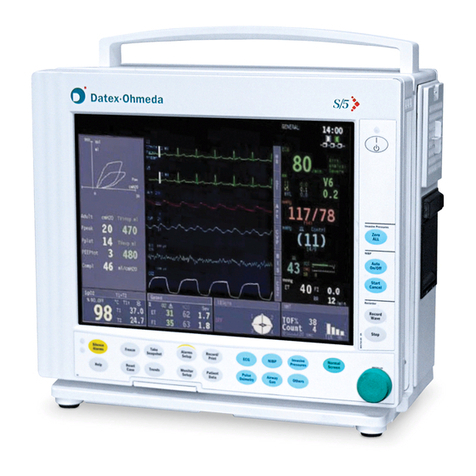
Datex-Ohmeda
Datex-Ohmeda S/5 Compact Anesthesia Monitor Technical reference manual
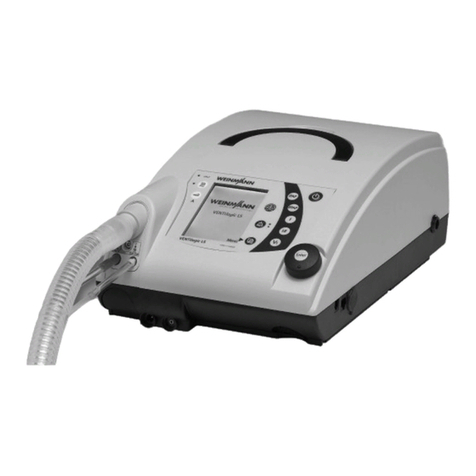
Weinmann
Weinmann VENTIlogic LS Instructions for use
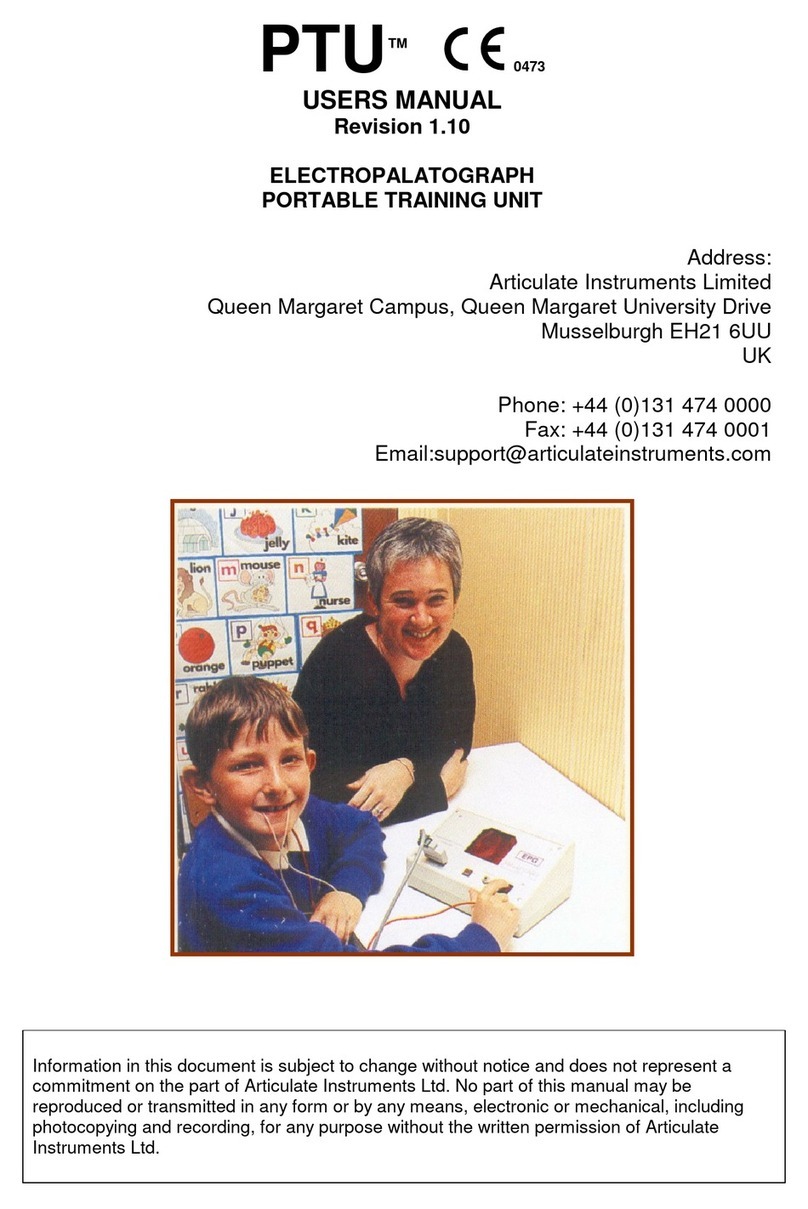
Articulate Instruments
Articulate Instruments PTU user manual
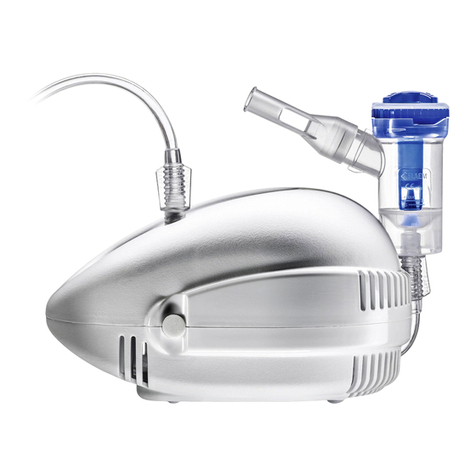
Flaem
Flaem AirMate Instructions for use manual

Precision Medical
Precision Medical EASY PULSE PM4150 SERIES Service manual
